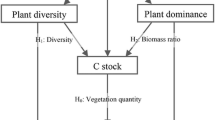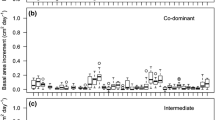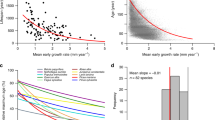Abstract
Experimental studies suggest that tree growth is stimulated in a greenhouse atmosphere, leading to faster carbon accumulation (i.e., a higher rate of gap filling). However, higher growth may be coupled with reduced longevity, thus leading to faster carbon release (i.e., a higher rate of gap creation). The net effect of these two counteracting processes is not known. We quantify this net effect on aboveground carbon stocks using a novel combination of data sets and modeling. Data on maximum growth rate and maximum longevity of 141 temperate tree species are used to derive a relationship between growth stimulation and changes in longevity. We employ this relationship to modify the respective parameter values of tree species in a forest succession model and study aboveground biomass in a factorial design of growth stimulation × reduced maximum longevity at multiple sites along a climate gradient from the cold to the dry treeline. The results show that (1) any growth stimulation at the tree level leads to a disproportionately small increase of stand biomass due to negative feedback effects, even in the absence of reduced longevity; (2) a reduction of tree longevity tends to offset the growth-related biomass increase; at the most likely value of reduced longevity, the net effect is very close to zero in most multi- and single-species simulations; and (3) when averaging the response across all sites to mimic a “landscape-level” response, the net effect is close to zero. Thus, it is important to consider ecophysiological responses with their linkage to demographic processes in forest trees if one wishes to avoid erroneous inference at the ecosystem level. We conclude that any CO2 fertilization effect is quite likely to be offset by an associated reduction in the longevity of forest trees, thus strongly reducing the carbon mitigation potential of temperate forests.



Similar content being viewed by others
References
Arendt JD (1997) Adaptive intrinsic growth rates: an integration across taxa. Q Rev Biol 72:149–177
Backman G (1943) Wachstum und organische Zeit. Verlag Johann Ambrosius Barth, Lepizig
Bigler C, Bugmann H (2003) Growth-dependent tree mortality models based on tree rings. Can J For Res 33:210–221
Bigler C, Veblen TT (2009) Increased early growth rates decrease longevities of conifers in subalpine forests. Oikos 118:1130–1138
Bormann DB, Likens GE (1979) Pattern and process in a forested ecosystem. Springer, New York
Botkin DB, Janak JF, Wallis JR (1972) Some ecological consequences of a computer model of forest growth. J Ecol 60:849–872
Bugmann H (1994) On the ecology of mountainous forests in a changing climate: a simulation study (PhD thesis, no. 10,638). Swiss Federal Institute of Technology, Zurich
Bugmann H (1996) A simplified forest model to study species composition along climate gradients. Ecology 77:2055–2074
Bugmann H (1997) An efficient method for estimating the steady-state species composition of forest gap models. Can J For Res 27:551–556
Bugmann H (2001a) A review of forest gap models. Clim Change 51:259–305
Bugmann H (2001b) A comparative analysis of forest dynamics in the Swiss Alps and the Colorado Front Range. For Ecol Manag 145:43–55
Bugmann H (2003) Predicting the ecosystem effects of climate change. In: Canham CD, Lauenroth WK, Cole JS (eds) Models in ecosystem science. Princeton University Press, Princeton, pp 385–409
Bugmann H, Cramer W (1998) Improving the behaviour of forest gap models along drought gradients. For Ecol Manag 103:247–263
Bugmann H, Solomon AM (1995) The use of a European forest model in North America: a study of ecosystem response to climate gradients. J Biogeogr 22:477–484
Bugmann H, Solomon AM (2000) Explaining forest composition and biomass across multiple biogeographical regions. Ecol Appl 10:95–114
Cramer W et al (2001) Global response of terrestrial ecosystem structure and function to CO2 and climate change: results from six dynamic global vegetation models. Glob Change Biol. 7:357–373
Friedlingstein P et al (2006) Climate–carbon cycle feedback analysis: results from the C4MIP model intercomparison. J Clim 19:3337–3353
Friend AD, Stevens AK, Knox RG, Cannell MGR (1997) A process-based, terrestrial biosphere model of ecosystem dynamics (Hybrid v3.0). Ecological Modelling 95:249–287
Gayler S, Grams TEE, Heller W, Treutter D, Priesack E (2008) A dynamical model of environmental effects on allocation to carbon-based secondary compounds in juvenile trees. Ann Bot 101:1089–1098
Granados J, Körner C (2002) In deep shade, elevated CO2 increases the vigor of tropical climbing plants. Global Change Biol 8:1109–1117
Handa IT, Körner C, Hättenschwiler S (2005) A test of the treeline carbon limitation hypothesis by in situ CO2 enrichment and defoliation. Ecology 86:1288–1300
Harcombe PA (1987) Tree life tables. Bioscience 37:557–568
Jenkins MA, Pallardy SG (1995) The influence of drought on red oak group species growth and mortality in the Missouri Ozarks. Can J For Res 25:1119–1127
Kimball BA, Pinter PJ, Garcia RL, LaMorte RL, Wall GW, Hunsaker DJ, Wechsung G, Wechsung F, Kartschall Th (1995) Productivity and water use of wheat under free-air CO2 enrichment. Glob Change Biol 1:429–442
Kimball BA, Idso SB, Johnson S, Rillig MC (2007) Seventeen years of carbon dioxide enrichment of sour orange trees: final results. Glob Change Biol 13:2171–2183
Kimmins JP (2004) Forest ecology. Prentice-Hall, Upper Saddle River
Körner C (2004) Through enhanced tree dynamics carbon dioxide enrichment may cause tropical forests to lose carbon. Phil Trans R Soc Lond B 359:493–498
Körner C (2006) Plant CO2 responses: an issue of definition, time and resource supply. New Phytol 172:393–411
Körner C (2009) Responses of humid tropical trees to rising CO2. Annu Rev Ecol Evol Syst 40:61–79
Körner C, Asshoff R, Bignucolo O, Hättenschwiler S, Keel SG, Pelaez-Riedl S, Pepin S, Siegwolf RTW, Zotz G (2005) Carbon flux and growth in mature deciduous forest trees exposed to elevated CO2. Science 309:1360–1362
Körner C, Morgan JA, Norby R (2007) CO2 fertilisation: when, where, how much? In: Canadell JG, Pataki D, Pitelka LF (eds) Terrestrial ecosystems in a changing world. Springer, Berlin, pp 9–21
Ladeau SL, Clark JS (2006) Elevated CO2 and tree fecundity: the role of tree size, interannual variability, and population heterogeneity. Glob Change Biol 12:822–833
Laurance WF, Nascimento HEM, Laurance SG, Condit R, D’Angelo S, Andrade A (2004) Inferred longevity of Amazonian rainforest trees based on a long-term demographic study. For Ecol Manag 190:131–143
Lavola A, Julkunen-Tiitto R (1994) The effect of elevated carbon dioxide and fertilization on primary and secondary metabolites in birch Betula pendula (Roth). Oecologia 99:315–321
Lexer MJ, Hönninger K (2001) A modified 3D-patch model for spatially explicit simulation of vegetation composition in heterogeneous landscapes. For Ecol Manag 144:43–65
Litvak ME, Constable JVH, Monson RK (2002) Supply and demand processes as controls over needle monoterpene synthesis and concentration in Douglas fir [Pseudotsuga menziesii (Mirb.) Franco]. Oecologia 132:382–391
Loehle C (1988) Tree life history strategies: the role of defenses. Can J For Res 18:209–222
Luo ZB, Calfapietra C, Scarascia-Mugnozza G, Liberloo M, Polle A (2008) Carbon-based secondary metabolites and internal nitrogen pools in Populus nigra under free air CO2 enrichment (FACE) and nitrogen fertilization. Plant Soil 304:45–57
Malhi Y, Meir P, Brown S (2002) Forests, carbon and global climate. Phil Trans R Soc Lond B 360:1567–1591
Moore AD (1989) On the maximum growth equation used in forest gap simulation models. Ecological Modelling 45:63–67
Moore DJP, Aref S, Ho RM, Pippen JS, Hamilton JG, DeLucia EH (2006) Annual basal area increment and growth duration of Pinus taeda in response to eight years of free-air carbon dioxide enrichment. Glob Change Biol 12:1367–1377
Norby RJ, Wullschleger SD, Gunderson CA, Johnson DW, Ceulemans R (1999) Tree responses to rising CO2 in field experiments: implications for the future forest. Plant Cell Environ 22:683–714
Norby RJ, Ledford J, Reilly CD, Miller NE, O’Neill EG (2004) Fine-root production dominates response of a deciduous forest to atmospheric CO2 enrichment. Proc Natl Acad Sci USA 101:9689–9693
Norby RJ et al (2005) Forest response to elevated CO2 is conserved across a broad range of productivity. Proc Natl Acad Sci USA 102:18052–18056
Oren R, Ellsworth DS, Johnsen KH, Phillips N, Ewers BE, Maier C, Schäfer KVR, McCarthy H, Hendrey G, McNulty SG, Katul GG (2001) Soil fertility limits carbon sequestration by forest ecosystems in a CO2-enriched atmosphere. Nature 411:469–472
Philips OL, Gentry AH (1994) Increasing turnover through time in tropical forests. Science 263:954–957
Philips OL et al (2004) Pattern and process in Amazon tree turnover, 1976–2001. Phil Trans R Soc Lond B 359:381–407
Prentice IC, Cramer W, Harrison SP, Hickler T, Lucht W, Sitch S, Smith B, Sykes MT (2007) Dynamic global vegetation modelling: quantifying terrestrial ecosystem responses to large-scale environmental change. In: Canadell JG, Pataki D, Pitelka LF (eds) Terrestrial ecosystems in a changing world. Springer, Berlin, pp 175–192
Purves DW, Lichstein JW, Pacala SW (2007) Crown plasticity and competition for canopy space: a new spatially implicit model parameterized for 250 North American tree species. PLoS ONE 2(9):e870
R Development Core Team (2008) R: a language and environment for statistical computing. R Foundation for Statistical Computing, Vienna. http://www.R-project.org
Reynolds JF, Bugmann H, Pitelka LF (2001) How much physiology is needed in forest gap models for simulating long-term vegetation response to global change? Challenges, limitations, and potentials. Clim Change 51:541–557
Schäfer KVR, Oren R, Ellsworth DS, Lai CT, Herrick JD, Finzi AC, Richter DD, Katul GG (2003) Exposure to an enriched CO2 atmosphere alters carbon assimilation and allocation in a pine forest ecosystem. Glob Change Biol 9:1378–1400
Schulman E (1954) Longevity under adversity in conifers. Science 119:396–399
Shao G, Bugmann H, Yan X (2001) A comparative analysis of the structure and behavior of three forest gap models at sites in northeastern China. Clim Change 51:389–413
Shugart HH (1984) A theory of forest dynamics: the ecological implications of forest succession models. Springer, New York
Shugart HH (1998) Terrestrial ecosystems in a changing environment. Cambridge University Press, Cambridge
Shugart HH, Emanuel WR (1985) Carbon dioxide increase: the implications at the ecosystem level. Plant Cell Environ 8:381–386
Vieira S, Trumbore S, Camargo PB, Selhorst D, Chambers JQ, Higuchi N, Martinelli LA (2005) Slow growth rates of Amazonian trees: consequences for carbon cycling. Proc Natl Acad Sci USA 102:18502–18507
Waring RH (1987) Characteristics of trees predisposed to die. Bioscience 37:569–573
Wright SJ, Calderon O, Hernandez A, Paton S (2004) Are lianas increasing in importance in tropical forests? A 17-year record from Panama. Ecology 85:484–489
Wunder J, Brzeziecki B, Żybura H, Reineking B, Bigler C, Bugmann H (2008) Growth–mortality relationships as indicators of life-history strategies: a comparison of nine tree species in unmanaged European forests. Oikos 117:815–828
Wyckoff PH, Clark JS (2002) The relationship between growth and mortality for seven co-occurring tree species in the southern Appalachian Mountains. J Ecol 90:604–615
Zotz G, Cueni N, Körner C (2006) In situ growth stimulation of a temperate zone liana (Hedera helix) in elevated CO2. Funct Ecol 20:763–769
Author information
Authors and Affiliations
Corresponding author
Additional information
Communicated by Christian Wirth.
Rights and permissions
About this article
Cite this article
Bugmann, H., Bigler, C. Will the CO2 fertilization effect in forests be offset by reduced tree longevity?. Oecologia 165, 533–544 (2011). https://doi.org/10.1007/s00442-010-1837-4
Received:
Accepted:
Published:
Issue Date:
DOI: https://doi.org/10.1007/s00442-010-1837-4




